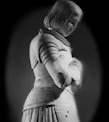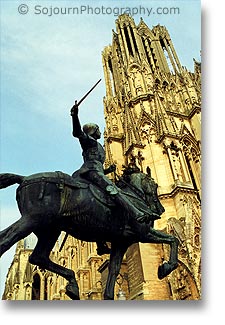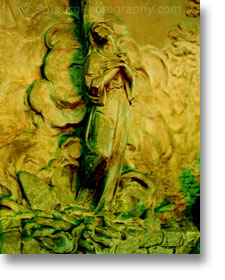|
|
||
|
|||
|
|||
|
|
|
||
|
|||
The Four Prophetic Responsibilities1. To drive out the English 2. To crown and anoint Charles VII in Reims Cathedral 3. To rescue the Duke of Orléans from the hands of the English 4. To raise the siege of Orléans |
|||
|
|||
On May 6, Joan exclaimed "In the name of God! let us go on bravely!" and proceeded to capture the English Fortress of the Augustines. That evening she requested that her chaplain stay close to her the next day as she prophesied "tomorrow blood will flow from my body, above my breast." Joan was the first to set a ladder against the fortress on May 7. Indeed, she was wounded by a crossbow bolt in the shoulder. Upon her return to the battle field, French soldiers were inspired to capture the bridge and the stronghold of Les Tourelles imminently sealing the fate of the English; on May 8, the siege was lifted. Thus it was that three days of battle over the course of four days lifted
the seven month siege of Orléans. Joan of Arc's first
military victory was her first battle. Other Prophecies5. The French defeat 6. Finds the King [Charles] "The esteemed Sir Robert de Baudricourt has sent us a girl he claims to be the Maid of Lorraine (of the legend that France would be lost by a woman and saved by a maiden woman from Lorraine) on a mission from God. But our eminent Bishop rightly insists upon proof. So, we will put her to the test in front of the entire court. Yes, yes you, La Trémouille will be seated on the throne and I shall be mingling with the assembly. If she ferrets the true king, she will have proven herself divinely inspired." [Cauchon] "His Majesty's, how shall I put it, boyish demeanor, is legend. She'll spot you at once. And then?" [Charles] "And then... won't it be fun? Bishop, don't be so dreary. (to the Bishop alone) If nothing else, the crowd will find it miraculous; it will reinforce their faith in God. And what's wrong with that?" [Cauchon] (to all) "There may be no harm
in seeing the girl." Indeed, presented with the imposter upon the throne, Joan was able to find Charles VII disguised among the crowd. 7. Her sword "Asked if she had been to Ste. Catherine de Fierbois, she answered yes; and there she heard Masses three times on the same day; and then went to Chinon.... She added that when she was at Tours or Chinon she sent for a sword which was in the church of St. Catherine de Fierbois, behind the altar; and immediately it was found there all rusted over. Asked how she knew that this sword was there, she answered that the sword was in the ground, rusted over, and upon it were five crosses; and she knew it was there through her voices, and she had never seen the man who fetched it. She wrote to the clergy of the place asking if it was their pleasure that she should have the sword, and they sent it to her. Nor was it buried deep behind the altar, but she believed she wrote saying it was behind. She added that as soon as the sword was found the priests rubbed it, and the rust fell off at once without effort; a merchant, an armorer of Tours, fetched it." from the Trial of Condemnation, Fourth Session 8. Her own efficacy 9. Wounded in Orléans
At her Trial of Rehabilitation, Father Jean Pasquerel testified that on May 6, 1429, Jehanne said "tomorrow blood shall flow from my body above my breast." On May 7, 1429, Joan of Arc led the attack on the English and was wounded in the shoulder by a crossbow bolt. 10. Seven years 11. The Death
Were Joan of Arc's Voices Ever Wrong?
Jehanne reported her voices had told her "Have no care for thy martyrdom; you will in the end come to the Kingdom of Paradise." It seems she may have contradicted herself here, and
if her voices were deceptive, it casts doubt over
all her claims of divine communication. Did God Lie?It was apparent for a time that Joan believed she would be delivered from captivity stating "those who wish to get her out of the world might well precede [her] being saved." Joan of Arc interpreted her martyrdom to mean what she had to endure in prison. Many believe it was this interpretation that initially led her to feel deceived and that this was a feeling she no longer had when she had more time to reflect on what her voices had been telling her. Certainly, she did not always immediately understand what her voices were saying to her, as was evident in her childhood. In any case, it is clear that in the end she held to all her voices had told her and declared them to have been the faithful word of God.
|
|||
go on to Becoming a Saint >>|Home| |Back to Top| |Contact Us| |Copyright ©| |Privacy Policy| |Site Map|
|
|||




